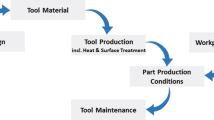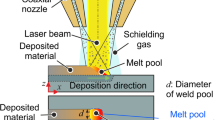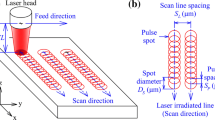Abstract
Direct laser melting (DLM) technology can be applied to restore damaged steel dies. To understand the effects of DLM process parameters such as the laser power and scan rate, a series of experiments was conducted to determine the optimal operating parameters. To investigate the laser melting characteristics, the depth/height ratio, depth/width ratio and micro-hardness as a function of the laser energy density were analyzed. Fe-Cr and Fe-Ni layers were deposited on a steel die with 11.38 J/mm2 of energy input. The wear-resistance and the friction coefficient of the deposited layer were investigated by a pin-on-disk test. The penetration depth decreased as the scan rate increased as a consequence of the shorter interaction time. The depth/height ratio of the deposited layer decreased with an increase in the scan rate. The depth/width ratio increased as laser power increased and the scan rate decreased. The deposition shape of the Fe-Ni powder was relatively shallow and wide compared with that of the Fe-Cr powder. The scan rate had a substantial effect upon the deposition height, with the Fe-Cr powder melting more than the Fe-Ni powder. The micro-hardness of the layer melted from the powders is higher than that of the substrate, and the hardness of the laser-surface-melted layer without any metal powder is higher compared to that of the metal-powder-melted layer. The direct laser melting process with Fe-Ni powder represents a superior method when restoring a steel die when the bead shape and hardness of the restored surface are important outcome considerations.
Similar content being viewed by others
References
A. J. Pinkerton and L. Li, Int. J. Adv. Manuf. Technol. 25, 471 (2005).
X. C. Wang, T. Laoui, J. Bonse, J. P. Kruth, B. Lauwers, and L. Froyen, Int. J. Adv. Manuf. Technol. 19, 351 (2002).
H. Y. Lee, T. J. Kim, and Y. J. Cho, J. Kor. Inst. Met. & Mater. 47, 267 (2009).
D. Cormier, O. Harrysson, and H. West, Rapid Prototyping J. 10, 35 (2004).
S. H. Zhang, M. X. Li, T. Y. Cho, J. H. Yoon, W. Fang, Y. K. Joo, J. H. Kang, and C. G. Lee, Met. Mater. Int. 14, 315 (2008).
R. Komanduri and Z. B. Hou, Inter. J. Heat Mass Transfer 44, 2845 (2001).
K. A. Chiang and Y. C. Chen, Mater. Lett. 59, 1919 (2005).
J. Grum and J. M. Slabe, Appl. Surf. Sci. 208–209, 424 (2003).
A. J. Pinkerton, W. Wang, and L. Li, Proc. Inst. Mech. Eng. Part B J. Eng. Manuf. 222, 827 (2008).
X. B. Liu, M. Pang, Z. G. Zhang, W. J. Ning, C. Y. Zheng, and G. Yu, Opt. Lasers Eng. 45, 929 (2007).
M. Rajabi, M. Vahidi, A. Simchi, and P. Davami, Mater. Charact. 60, 1370 (2009).
M. H. Jones and D. Scott, Industrial Tribology: The Practical Aspects of Friction, Lubrication and Wear, Elsevier Scientific Publishing Company, New York (1983).
J. A. Williams, Tribol. Int. 38, 863 (2005).
J. H. Jang, B. D. Joo, J. H. Lee, and Y. H. Moon, Met. Mater. Int. 15, 903 (2009).
W. M. Steen and C. H. G. Courtney, Metals Technol. 6, 456 (1979).
R. Sagaro, J. S. Ceballos, A. Blanco, and J. Mascarell, Wear 225–229, 575 (1999).
K. A. Mumtaz, P. Erasenthiran, and N. Hopkinson, J. Mater. Process. Technol. 195, 77 (2008).
J. P. Kruth, L. Froyen, J. Van Vaerenbergh, P. Mercelis, M. Rombouts, and B. Lauwers, J. Mater. Process. Technol. 149, 616 (2004).
L. Peng, Y. Taiping, L. Sheng, L. Dongsheng, H. Qianwu, X. Weihao, and Z. Xiaoyan, Int. J. Mach. Tools Manuf. 45, 1288 (2005).
E. Capello and B. Previtali, J. Mater. Process. Technol. 174, 223 (2006).
M. F. Jensen, J. Bøttiger, H. H. Reitz, and M. E. Benzon, Wear 253, 1044 (2002).
H. So, Wear 184, 161 (1995).
B. Y. Choi and H. K. Kim, J. Kor. Inst. Met. & Mater. 47, 667 (2009).
D. J. Ha, H. K. Sung, J. W. Park, and S. H. Lee, J. Kor. Inst. Met. & Mater. 47, 406 (2009).
Author information
Authors and Affiliations
Corresponding author
Rights and permissions
About this article
Cite this article
Jang, J.H., Joo, B.D., Mun, S.M. et al. Application of direct laser melting to restore damaged steel dies. Met. Mater. Int. 17, 167–174 (2011). https://doi.org/10.1007/s12540-011-0223-z
Received:
Accepted:
Published:
Issue Date:
DOI: https://doi.org/10.1007/s12540-011-0223-z




